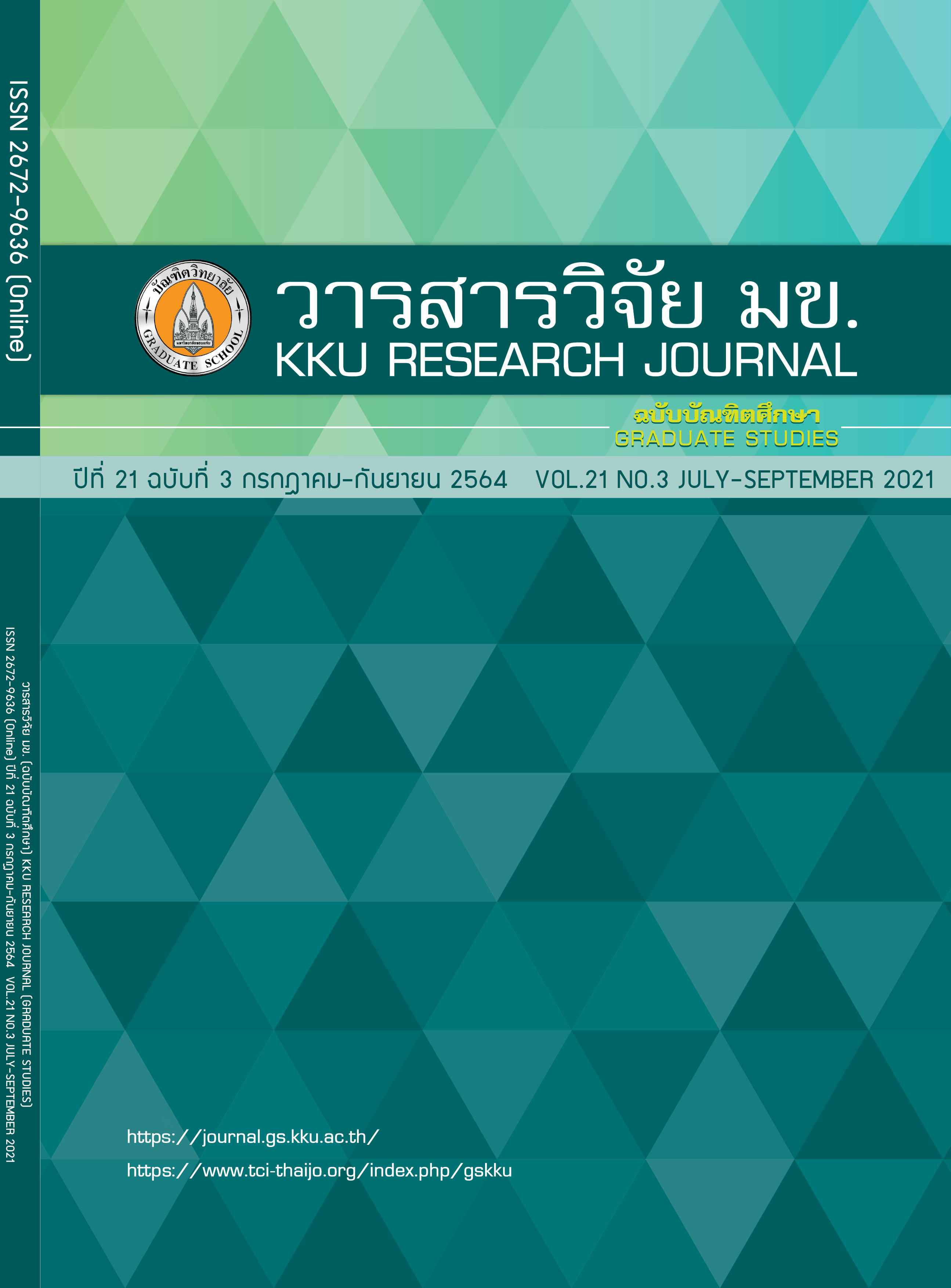Size Distribution of Particulate Matter in Different Areas of Khon Kaen Province
Keywords:
PM10, PM2.5, Size distribution of particulate matterAbstract
The objective of this research was to study the quantity of PM10, PM2.5 and the differences of distribution size of particulate matter that affects the respiratory system from overcrowded agricultural area, traffic area, market area in Khon Kaen province. The data was collected by ACI 8 stage. The result showed that the area that had highest particulate matter quantity in winter was agricultural area. The average of PM10 and PM2.5 represents respectively of 106.66±7.80 and 42.28±3.93 µg./m3 In summer, the highest particulate matter quantity was also in agricultural area with the average of 92.87±9.75 and 45.75±7.60 µg./m3 respectively. statistical analysis independent t-test indicated that there was no significantly different (P-value>0.05). and One-way ANOVA revealed that PM10 in winter was significantly different in all 3 areas (p-value <0.05). It was found that agriculture area in both winter and summer have the same size distribution of particulate matter. The mostly found was particulate matter with a size >4.7 microns, representing 46.74 and 39.53 percent respectively. It was also found that particulate matter with a size >4.7 microns represent 42.37 and 40.14 percent respectively in overcrowded traffic area in both winter and summer. The particulate matter with a size >4.7 microns can be accumulated in the nose and throat of human. Differently, the particulate matter that found in the market area in both winter and summer is <1.1 microns with representing respectively only 37.51 and 36.88 percent. The particulate matter with a size <1.1 microns can be accumulated in pulmonary alveoli.
References
Nemmar A, Inuwa IM. Diesel exhaust particles in blood trigger systemic and pulmonary morphological alterations. Toxicology Letters. 2008; 176(1): 20-30.
Walker B, Mouton CP. Environmental influences on cardiovascular health. Journal of the National Medical Association. 2008; 100(1), 98-102.
Greenpeace. Ranking of cities with air pollution problems [Internet]. 2018 [cited 2019 May 18]. Available from https://www.greenpeace.org/thailand/publication/3139/
HEI. Improve Air Quality Public Health [Internet]. 2019 [cited 2019 September 10]. Available from https://www.healtheffects.org/
IHME. Air Pollution [Internet]. 2019. [cited 2019 May 10] Available from http://www.healthdata.org/air-pollution
WHO. Health Effects of Particulate Matter. Policy implications for countries in eastern Europe, Caucasus and central Asia. 2013.
HPC 7. Analyze the situation of particles not larger than 2.5 microns in Health Center Area 7 [Internet]. 2019 [cited 2019 May 17] Available from http://www.kkpho.go.th/i/index.php/component/5830.html
Greenpeace. PM10 and PM2.5 Report in Thailand [Internet]. 2018 [cited 2019 January 7] Available from https://www.greenpeace.org/thailand/
Pollution Control Department. State of Pollution in Thailand in 2019 [Internet]. 2019 [cited 2019 April 12] Available from http://www.pcd.go.th
HDC. Occupational and environmental diseases [Internet]. 2020. [cited 2020 March 20] Available from https://kkn.hdc.moph.go.th/hdc/reports/
Thermo electron corporation. Eight Stage Non-Viable Impactor (Series 20-800 Mark II) [Internet]. 2004 [cited 2019 May 11] Available from http://www.thermo.com/com/cda/product/detail/1,1055,22485, 00.html
Thermo scientific. Eight-Stage Non-Viable Andersen Cascade Impactor [Internet]. 2004 [cited 2019 May 15] Available from http://www.thermoscientific.com/en/product/eight-stage-non-viableandersen-cascade-impactor.html
Khotmanee K. Open burning situation and particulate matter in the environment form agriculture burning case study in Kumphawapi Udon Thani Province. Thailand Journal of Health Promotion and Environmental. 2008; 11(3): 15-26.
Chutichaisakda M. Determination of PM2.5 Fraction in PM10 Generated by Traffic Source in Chiang Mai Municipality. Master of Environmental Engineering. Chiang Mai University. 2014.
Rangjob K, Nathapindhu G. (2011). Particle Size Distribution in the Activities Grilling Process. KKU Journal for Public Health Research. 2011; 5(2): 11-20.
Phoothiwut S. Distribution of Polycyclic Aromatic Hydrocarbons on Different Sizes of Particulate Matters Emitted from Biomass Open Burning. The Requirement for The Degree of Master of Science in Environmental Chemistry Faculty of Science. King Mongkut’s Institute of Technology Ladkrabang. 2009.
Nirmalkar J, Manas KD. Impact of intense field burning episode on aerosol mass loading and its possible health implications in rural area of eastern central India. Air Qual Atmos Health. 2016; 9(1): 241-249.
Ny MT, Lee BK. Size Distribution of Airborne Particulate Matter and Associated Metallic Elements in an Urban Area of an Industrial City in Korea. Asian Journal of Atmospheric Environment. 2011; 4(1): 9-19.
Oh MS, Lee TJ, Kim DS. Quantitative Source Apportionment of Size-segregated Particulate Matter at Urbanized Local Site in Korea. Aerosol and Air Quality Research. 2011; 11(1): 247–264.



